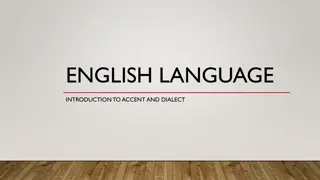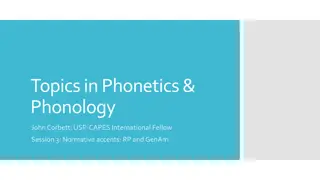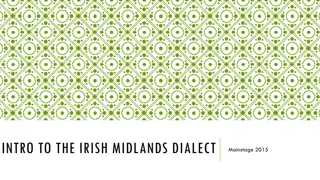Exploring English Accents: A Diverse Linguistic Landscape
English accents are vast and varied, with over 40 accents and dialects in the UK alone. From Received Pronunciation to Cockney and Yorkshire accents, each carries its unique characteristics and cultural significance. Discover the richness of English accents and their impact on communication and identity.
Download Presentation

Please find below an Image/Link to download the presentation.
The content on the website is provided AS IS for your information and personal use only. It may not be sold, licensed, or shared on other websites without obtaining consent from the author. Download presentation by click this link. If you encounter any issues during the download, it is possible that the publisher has removed the file from their server.
E N D
Presentation Transcript
English Accents Akcenty j zyka angielskiego
What accent is? The Oxford Lexico dictionary defines an accent to be a distinctive way of pronouncing a language, especially one associated with a particular country, area, or social class.
introduction One language, over one billion native speakers, and countless ways to speak it. The lingua franca of the world has its fair share of accents depending on the country and even region you are in. So, the big question is: how many varieties of English accents are there? Well, unfortunately, we can t know for sure worldwide but there are somewhere over 40 English accents and dialects in the United Kingdom alone!
Received Pronunciation Received Received Pronunciation Pronunciation, or RP often described as typically British . It is variously referred to as the Queen s English , BBC English or Oxford English . It s often associated with the middle to upper classes and is the accent you would typically hear on BBC News or in period drama series such as Downtown Abbey or Bridgerton. RP is probably the most widely studied and most frequently described variety of spoken English in the world, yet recent estimates suggest only 3% of the UK population speak it. It is the accent on which phonemic transcriptions in dictionaries are based, and it is widely used (in competition with General American) for teaching English as a foreign language. Some characteristics of the Received Pronunciation accent are that the r at the end of words isn t pronounced, so mother sounds like muh-thuh. Additionally, certain words such as chance, bath, and dance are pronounced with the long-sounding A as in father. RP for short, is the instantly recognisable accent
Cockney Cockney Cockney, accent of the English language traditionally spoken by working-class Londoners. Cockney is also often used to refer to anyone from London in particular, from East End. It s probably the most iconic of them all and one that is instantly recognizable. Cockney was born as the dialect of the working classes in the East End of London. The Cockney accent is characterized by the letter t being pronounced with less intensity, or almost ignored altogether. This is called a glottal stop in phonetics. Therefore, words like better are pronounced more like beh-uh. Letters at the beginning of some words can also get dropped such as the h in front of head so it would sound more like ed. Some vowel sounds also get shifted, so words like day sound like die, and buy is more like boy. (London)
Yorkshire The Yorkshire dialect is native to Northern England, spoken in the largest county in the UK, Yorkshire. Home to Leeds, York, and Sheffield you can imagine that there is actually a lot of variation within the Yorkshire accent. The Yorkshire accent, like many regional accents, is also often the butt of some jokes. This English accent can be difficult to explain, but is characterized by a flat yet friendly- sounding pronunciation. Furthermore, words that normally have an ee sound at the end are pronounced eh. For example, happy sounds more like hap-peh.
Scottish Of course, you will understand scottish people. Besides, they mostly use their own language only when talking to fellow Scots. Some defining features of the Scottish accent is that any r s are generally rolled and vowel sounds are elongated. For example, the word face is pronounced fay-ce. Apart from the rolled r and the characteristic ch (as in loch) sound, most of the differences in accent alone between the south of England and the north of Scotland are in the vowels. (Scotland)
Welsh With almost 30% of the population of Wales speaking Welsh, their dialect of English is naturally heavily influenced by the Welsh language. The Welsh accent, unlike most British accents, has a clearly defined geographical area: Wales. While part of the United Kingdom, Wales is its own country. Welsh English, surprisingly, is arguably a younger variety than the English spoken in the USA. Welsh is a very friendly accent with an interesting rhythm to it. The Welsh accent is very notable for its singsong nature. They stretch out vowels and lengthen them. For example, in the sentence "Jane, how's it going?" they say "Ja-ane, how's it go-o-en?" When pronouncing the "i" sound in words such as doing, going, they pit and lit, the "i-" sound becomes reminiscent of an e, as shown in step one, where "going" is pronounced "go-o-en", in the sense that the "o" is stretched out and the "ing" suffix is said "en". Some letters are slurred; for example, "h" and "f" are often skipped or slurred where "have" becomes "ave" and "of" becomes "ov". This is not for all letters though so do this with only "h", "f" and other "soft" letters. They do not do this with vowels. "Y" sounds are also frequently dropped. So instead of saying "Tell Jake the news" they say "Tell Jake the ooz". "R" sounds have a very slight roll to them.
Northern Irish Across the pond from the British Isles is one of our all-time favorite accents the Northern Irish accent. There are lots of definitive words and phrases that make the Northern Irish dialect so distinctive such as the words wee meaning small (like in Scottish as well), and lassie meaning young girl. The Northern Irish accent is characterized by rising intonation at the end of sentences, even when it s not a question, and an exaggerated r sound at the end of sentences pronounced like arrr. Speech in the whole of Ireland is for instance rhotic rhotic that is speakers pronounce an <r> sound after a vowel in words like farm, first and better. There people insert a <y> sound after an initial <k> or <g> in words like car and garden, such that they sound a little like kyarr or gyarrden . Northern Irish English also has a very distinctive intonation pattern and a broad Northern Irish accent is characterised by a very noticeable tendency to raise the pitch towards the end of an utterance, even if the speaker is not asking a question.
Northern USA English accent the Northern United States is a linguistic super-region of English dialects, defined by /o / (as in goat, toe, show, etc.) and traditionally /u/ (as in goose, too, shoe, etc.) pronounced conservatively far in the back of the mouth, "r-fulness" (or rhoticity), and a common lack of the cot caught merger, meaning that words like pond and pawned, or bot and bought, are not pronounced identically (with the second of this class of words being pronounced usually farther back in the mouth and with more rounded lips).
Accent in New York City Starting off with one of the most iconic American accents - the New York City accent. To sound like a New Yorker, elongate your vowels into an awww sound, especially a s and o s. For example, coffee is pronounced like "caw-fee" and talk as tawk. Another thing you might notice is that New Yorkers pronounce words beginning with re with a soft ra . For example, regardless would be pronounced ra- gardless and return as ra-turn.
Southern American English accent The first noticeable thing about a Southern accent is the speed at which it is spoken. The Southern accent is slower and laid back as noticed in their drawn-out vowel sounds known as the Southern drawl. Words typically run together like gonna (going to) and lemme (let me). Some words that typically have two syllables instead have one such as the word tire being pronounced like taar. I is also pronounced more like aah and mah for my. Putting that all together, you might hear a sentence like "lordy be, aah've got a flat taar" (Oh no, I have a flat tire.)
Canadian accent Canadian English contains elements of both British and American English, as well as some uniquely Canadian characteristics of its own. The vast majority of people outside of the country cannot distinguish the Canadian accent from the American one by sound alone. The giveaway for most is when a Canadian pronounces the word about as a-boot. British English preferences are found in words like news, which the Canadians pronounce like nyoos rather than noos.
Australian English accent Compared to British English and the North American English accents, the Australian accent is more homogeneous. It shares the most similarity with New Zealand English. The Australian accent is famous for the use of an inflection at the end of sentences, which can make statements sound like questions. When a t comes between two vowels in a word, it sounds like a d. For example, he drinks a lot of water would be pronounced like he dinks alodda wader. The ending of some words requires the jaw to drop quite a bit allowing a more wide and open sound. For example, letter would be pronounced like led-dah and neighbor as neigh-bah.
rda: https://en.wikipedia.org/wiki/Regional_accents_of_English http://pl.enlizza.com/11-najczestszych-akcenty-angielski/ https://www.bl.uk/british-accents-and-dialects/articles/received- pronunciation https://www.tandem.net/blog/introduction-to-english-accents https://www.britannica.com/topic/Cockney https://www.wikihow.com/Speak-with-a-Welsh-Accent https://www.bl.uk/british-accents-and-dialects/articles/accents-and- dialects-of-northern-ireland https://en.wikipedia.org/wiki/Southern_American_English























